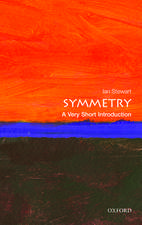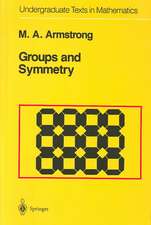Introductory Group Theory: and Its Application to Molecular Structure
Autor John R. Ferraro, Joseph S. Ziomeken Limba Engleză Paperback – 23 oct 2012
| Toate formatele și edițiile | Preț | Express |
|---|---|---|
| Paperback (2) | 385.08 lei 6-8 săpt. | |
| Springer Us – 1969 | 385.08 lei 6-8 săpt. | |
| Springer Us – 23 oct 2012 | 385.47 lei 6-8 săpt. |
Preț: 385.47 lei
Nou
Puncte Express: 578
Preț estimativ în valută:
73.76€ • 77.17$ • 61.27£
73.76€ • 77.17$ • 61.27£
Carte tipărită la comandă
Livrare economică 02-16 aprilie
Preluare comenzi: 021 569.72.76
Specificații
ISBN-13: 9781461371854
ISBN-10: 1461371856
Pagini: 240
Ilustrații: XIII, 240 p.
Dimensiuni: 152 x 229 x 14 mm
Greutate: 0.35 kg
Ediția:1969
Editura: Springer Us
Colecția Springer
Locul publicării:New York, NY, United States
ISBN-10: 1461371856
Pagini: 240
Ilustrații: XIII, 240 p.
Dimensiuni: 152 x 229 x 14 mm
Greutate: 0.35 kg
Ediția:1969
Editura: Springer Us
Colecția Springer
Locul publicării:New York, NY, United States
Public țintă
ResearchDescriere
This volume is a consequence of a series of seminars presented by the authors at the Infrared Spectroscopy Institute, Canisius College, Buffalo, New York, over the last nine years. Many participants on an intermediate level lacked a sufficient background in mathematics and quantum mechan ics, and it became evident that a non mathematical or nearly nonmathe matical approach would be necessary. The lectures were designed to fill this need and proved very successful. As a result of the interest that was developed in this approach, it was decided to write this book. The text is intended for scientists and students with only limited theore tical background in spectroscopy, but who are sincerely interested in the interpretation of molecular spectra. The book develops the detailed selection rules for fundamentals, combinations, and overtones for molecules in several point groups. Detailed procedures used in carrying out the normal coordinate treatment for several molecules are also presented. Numerous examples from the literature illustrate the use of group theory in the in terpretation of molecular spectra and in the determination of molecular structure.
Cuprins
1 Symmetry in General.- 1-1. Introduction.- 1-2. Definition of Symmetry.- 1-3. Symmetry in Our Culture.- 1-4. Symmetry in Nature.- 1-5. Symmetry in Science.- 1-6. References.- 2 Symmetry in Chemistry.- 2-1. Introduction.- 2-2. Symmetry Elements.- 2-3. Point Groups.- 2-4. Rules for Classification of Molecules into Point Groups.- 2-5. Problems.- 2-6. References.- 2-7. Bibliography.- 3 Elementary Mathematics.- 3-1. Definition of a Group.- 3-2. Finite and Infinite Groups.- 3-3. Subgroups.- 3-4. Classes.- 3-5. Definition of a Matrix.- 3-6. Multiplication of Matrices.- 3-7. Transpose of a Matrix.- 3-8. Representation of Groups.- 3-9. Problems.- 3-10. References.- 4 The Character Table.- 4-1. Introduction.- 4-2. Types of Representations.- 4-3. Character Tables for the More Common Point Groups.- 4-4. Problem.- 5 Derivation of Selection Rules.- 5-1. Derivation of Selection Rules for Nonlinear Molecules of the Most Common Point Groups.- 5-2. The Td Point Group.- 5-3. The D4h Point Group.- 5-4. The Oh Point Group.- 5-5. The D3h Point Group.- 5-6. The C3v Point Group.- 5-7. The C2v Point Group.- 5-8. Derivation of Selection Rules for Linear Molecules.- 5-9. Problem.- 5-10. References.- 6 Potential Force Fields.- 6-1. The General Quadratic Potential Function.- 6-2. The Central Force Field.- 6-3. The Valence Force Field.- 6-4. The Generalized Valence Force Field.- 6-5. The Urey—Bradley Function.- 6-6. References.- 7 The Normal Coordinate Treatment for Molecules with C2v, C3v, Td, and Oh Symmetry.- 7-1. Procedure Necessary in the NCT Method.- 7-2. Normal Coordinate Treatment of H2O (C2v Symmetry).- 7-3. Normal Coordinate Treatment of NH3(C3v Symmetry).- 7-4. Normal Coordinate Treatment of CH4(Td Symmetry).- 7-5. Normal Coordinate Treatment of UF6(OhSymmetry).- 7-6. Some Results of NCT of Molecules.- 7-7. The Product Rule.- 7-8. The Sum Rule.- 7-9. Summary.- 7-10. Problems.- 7-11. References.- 8 Applications of Group Theory.- 8-1. Introduction.- 8-2. Procedure Used in Determing the Structure of a Molecule.- 8-3. Examples Illustrating the Use of Group Theory in Determining Molecular Structure.- 8-4. Practice Problem.- 8-5. Selection of Rules for A3 to A8 Molecules.- 8-6. Forbidden Vibrations for Several Point Groups.- 8-7. Problems.- 8-8. References.- Appendices.- 1. Conversion Table for Wavelength and Wave Number Units.- 3. Diagrams of Normal Vibrations for Common Point Groups.- 4. Calculation of Thermodynamic Functions for Vibrational—Rotational Spectra.- 6. General Method of Obtaining Molecular Symmetry Coordinates.- 7. Conversion Chart for Various Forms of Energy and Velocities.

















